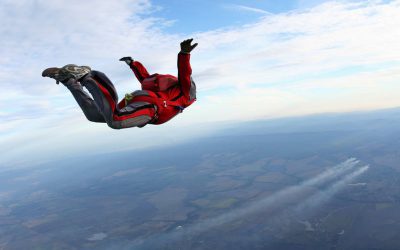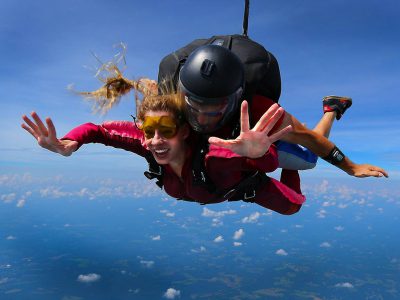In skydiving, there’s an old saying that still rings true: “It’s better to be on the ground wishing you were in the air, than in the air wishing you were on the ground.” These words may sound simple, but they carry a profound truth about the importance of safety in our sport.
While sunny skies might seem inviting at first, it’s the unseen dangers of gusty winds that can change your skydiving plans significantly. Staying grounded during a wind hold isn’t just a precaution – it’s a vital part of ensuring that your skydive is as safe and enjoyable as possible. Here’s why!
What Weather is Bad for Skydiving?
 Several weather conditions can interfere with skydiving, making it unsafe and/or an uncomfortable experience for the jumpers. These include:
Several weather conditions can interfere with skydiving, making it unsafe and/or an uncomfortable experience for the jumpers. These include:
- Rain
- Clouds
- Wind
What is a Skydiving Wind Hold?
A “wind hold” occurs when skydiving operations are temporarily paused due to unsafe wind conditions. This decision is made by the dropzone’s Safety & Training Advisor (S&TA) and airplane pilots to ensure the well-being of everyone involved in the skydive.
We are in the business of mitigating as much risk as possible. This means we take extra precautions to ensure weather conditions are perfect for skydiving before even attempting to jump.
How Windy is Too Windy for Skydiving?
Because different regions are susceptible to different average wind speeds, there is no published tandem skydiving wind limit. Rather, the decision to skydive or not is left to the tandem instructor, the S&TA, the pilots, and the dropzone owner (DZO). To make the decision on whether or not it is a safe skydiving wind speed or to go on a wind hold, the dropzone will consider a few things. Wind holds can happen for a variety of reasons:
Wind Gusts
Usually, the first thing we look at is the wind gusts – which are characterized by brief periods where the wind speeds increase. The “spread” in the speed of these gusts is particularly important when determining if it’s safe enough to jump. For instance, if the wind is coming from a good direction, a gust from 5 knots to 10 knots may be completely manageable – while a gust of 0 knots to 14 knots is a different story.
To have the best chance of a successful skydive, the wind speed must be somewhat steady. Huge gusts of wind can not only make for a bumpy ride but have the potential to drastically affect the flight performance of the parachute.
Turbulence
Turbulence is another wind factor that could be dangerous for skydiving. What might seem like a little breeze could become far more sinister when it comes time to land the parachute.
As wind travels over the surface of the Earth, it encounters obstacles that can create vortices behind them. These swirling winds – sometimes called dirty air – cause turbulence and can cover a span of area 10 to 20 times the height of the obstacle that the wind encountered.
The problem with determining turbulence is that we cannot see it. Luckily, we can predict its presence by looking at the wind direction. On any given day, the winds may come from a direction that could cause significant turbulence for landing parachutes. If this is the case, the dropzone usually makes the call to go on a wind hold until the wind shifts and it is determined “safer” to resume operations.
Winds at Exit and Opening Altitude
When determining if winds are safe enough to jump in, we must look at the wind speeds and direction at each level of the skydive. Occasionally, the winds from our exit altitude of 14,000 feet to our parachute deployment can be so severe that it is deemed unsafe for skydiving.
 Why, you ask? Well, excessive wind speeds at exit can cause significant freefall drift, making it harder to get back to the landing area. This means jumpers could potentially land off in unsafe landing areas that contain hazards like power lines, parking lots, buildings, and so forth.
Why, you ask? Well, excessive wind speeds at exit can cause significant freefall drift, making it harder to get back to the landing area. This means jumpers could potentially land off in unsafe landing areas that contain hazards like power lines, parking lots, buildings, and so forth.
The same goes for high winds at parachute opening altitude – especially for large tandem canopies – as it can potentially prevent the tandem pair from making it back to the landing area safely.
How Do We Measure Wind Speed?
Skydivers have a variety of tools, old and new, that we use to determine wind speed at the dropzone. Usually, each tool is used to get the most accurate answer – coupled with experience – to make one general decision.
Windsocks
A traditional – and decorative – way to determine wind speed is by using windsocks. Windsocks are not only great for determining wind direction, it can also be used to give us an estimate of the speed of the wind. For example, if a 15-knot windsock is fully inflated, we can assume that the wind speeds are 15 knots or higher at the location of the windsock. Each marking on the windsock determines the speed of the wind.
Anemometer
Another common device used to measure wind speeds at skydiving centers is the Anemometer. This handheld instrument is held into the wind and reads real-time wind speed and gusts. Pretty nifty!
AWOS
The Automated Weather Observation System (AWOS) is a service provided by airports in surrounding areas to read out the most current weather and wind reports. This is a great resource, however, it is not always accurate as it only reports in certain regions.
Winds Aloft
Another great tool is Winds Aloft. Winds Aloft is a website that uses data from the National Oceanic and Atmospheric Administration (NOAA) forecast models to provide accurate wind speeds at different altitudes for skydivers and parachutists.
To Wait or To Reschedule?
When weather conditions aren’t ideal, you may face the decision to either wait it out or reschedule your jump. The dropzone will keep you as informed as possible with constant communication as they monitor changes.
If the wind or weather is expected to clear up within a few hours, our staff may advise you to stay and wait for a safe jumping window. This is why we typically advise tandem students to set aside five to six hours for their skydiving adventure in the case of bad weather. We have vending machines for drinks and snacks available on-site, and you’re welcome to pack a cooler with snacks and drinks – just remember that alcohol is prohibited.
If you’re not able to wait, or would rather reschedule for a different day when the weather is more favorable, you’re welcome to do so! We understand that rescheduling may be disappointing, but keep in mind that safety always comes first. We want you to have the best experience possible and weather plays a huge role in that. Most dropzones have flexible rescheduling policies for weather-related conditions – it’s simply out of our hands.
If you have any questions about tandem skydiving wind limits or would like more information, get in touch – one of our awesome team members at Skydive Monroe would love to help you out. Blue skies (and favorable winds) to all!
Copyright © 2025, Skydive Monroe, All Rights Reserved.
DropZone Web Design & Marketing by Beyond Marketing, LLC



